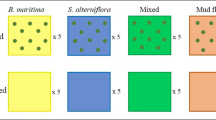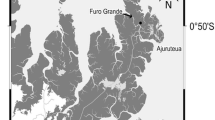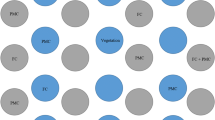Abstract
Positive plant–animal interactions are important in community ecology, but relatively little attention has been paid to their effect on the production of mangroves, dominant halophytic trees in tropical coastal marshes. Here, the role of fiddler crab (Uca spp.) burrowing on the growth and production of the white mangrove, Laguncularia racemosa (<2 years old), was examined in a restored marsh in Tampa Bay, Florida (27°41.65 N, 82°30.34 W) with manipulative experiments from June 2006 to May 2007. Fiddler crab burrowing significantly increased mangrove height by 27%, trunk diameter by 25%, and leaf production by 15%, compared to mangroves in crab exclusion enclosures. Additionally, the exclusion of fiddler crabs significantly increased interstitial water salinity from 32.4 to 44.2, and decreased the oxidation–reduction potential of the low organic sediments, but did not affect soil pH or sulfide concentration. Mangrove height, trunk diameter, and leaf production along a transect that varied in crab burrow density were positively associated with the number of crab burrows. Further, the density of sympatric Spartina alterniflora shoots was positively correlated with crab burrow density along the transect. As in temperate marshes, fiddler crabs can have significant ecological effects on mangrove communities, serving as ecological engineers by modulating the amount of resources available to marsh plants, and by altering the physical, chemical, and biological state of these soft sediment communities. In restored coastal systems that typically have very poor sediment quality, techniques such as soil amendment could be used to facilitate a more natural interaction between crabs and mangroves in ecosystem development.





Similar content being viewed by others
References
Allen EA, Curran HA (1974) Biogenic sedimentary structures produced by crabs in lagoon margin and salt marsh environments near Beaufort, North Carolina. J Sediment Petrol 44:538–548
Alongi DM (2002) Present state and future of the world’s mangrove forests. Environ Conserv 29:331–349. doi:10.1017/S0376892902000231
Baerlocher F, Moulton VD (1999) Spartina alterniflora in two New Brunswick salt marshes. I. Growth and decomposition. Bull Mar Sci 64:299–305
Berger U, Adamsb M, Grimmc V, Hildenbrandt H (2006) Modeling secondary succession of neotropical mangroves: causes and consequences of growth. Perspect Plant Ecol 7:243–252. doi:10.1016/j.ppees.2005.08.001
Bertness MD (1985) Fiddler crab regulation of Spartina alterniflora production on a New England salt marsh. Ecology 66:1042–1055
Bertness MD, Callaway R (1994) Positive interactions in communities. Trends Ecol Evol 9:191–193
Bertness MD, Leonard GH (1997) The role of positive interactions in communities: lessons from intertidal habitats. Ecology 78:1976–1989
Bertness MD, Miller T (1984) Fiddler crab burrow dynamics across a New England salt marsh. J Exp Mar Biol Ecol 83:211–237
Bird ECF (2008) Coastal geomorphology: an introduction, 2nd edn. Wiley, Hoboken
Bradley PM, Morris JT (1990) Influence of oxygen and sulfide concentration on nitrogen uptake kinetics in Spartina alterniflora. Ecology 71:282–287
Cannicci S, Burrows D, Fratini S, Smith TJ III, Offenberg J, Dahdouh-Guebas F (2008) Faunal impact on vegetation structure and ecosystem function in mangrove forests: a review. Aquat Bot 89:186–200. doi:10.1016/j.aquabot.2008.01.009
Carlson PR, Yarbro LA, Zimmerman CF, Montgomery JR (1983) Pore water chemistry of an overwash mangrove island. Florida Sci 46:239–249
Carlton JM (1974) Land building and stabilization by mangroves. Environ Conserv 1:285–294
Chapman VJ (1975) Mangrove biogeography. In: Walh G, Snedaker S, Teas H (eds) International symposium on the biology and management of mangroves. University of Florida, Gainesville, pp 3–22
Chen R, Twilley RR (1998) A gap dynamic model of mangrove forest development along gradients of soil salinity and nutrient resources. J Ecol 86:37–51. doi:10.1046/j.1365-2745.1998.00233.x
Cintrón G, Lugo A, Pool DJ, Morris G (1978) Mangroves of arid environments in Puerto Rico and adjacent islands. Biotropica 10:110–121
Day JW Jr, Coronado-Molina C, Vera-Herrera FR, Twilley RR, Rivera-Monroy VH, Alvarez-Guillen H, Day R, Conner W (1996) A seven year record of aboveground net primary production in a southeastern Mexican mangrove forest. Aquat Bot 55:39–60
Ellison AM, Farnsworth EJ, Twilley RR (1996) Facultative mutualism between red mangroves and root-fouling sponges in Belizean mangal. Ecology 77:2431–2444. doi:10.2307/2265744
FDEP (Florida Department of Environmental Protection) (1987) Cockroach Bay Aquatic Preserve Management Plan. http://www.dep.state.fl.us/coastal/downloads/management_plans/aquatic/CockroachBay.pdf
Feller IC, Whigham DF, McKee KL, Lovelock CE (2003) Nitrogen limitation of growth and nutrient dynamics in a disturbed mangrove forest, Indian River Lagoon, Florida. Oecologia 134:405–414. doi:10.1007/s10021-007-9025-z
Flowers TJ, Troke PF, Yeo AR (1977) The mechanism of salt tolerance in halophytes. Annu Rev Plant Physiol 28:89–121
Gill AM, Tomlinson PB (1977) Studies on the growth of red mangrove (Rhizophora mangle L.). II. Growth and differentiation of aerial roots. Biotropica 3:63–77
Gonzalias AE, Kuschk P, Wiessner A, Jank M, Kaster M, Koser H (2007) Treatment of an artificial sulfide containing wastewater in subsurface horizontal flow laboratory-scale constructed wetlands. Ecol Eng 31:259–268. doi:10.1016/j.ecoleng.2007.08.002
Gribsholt PM, Kostka JE, Kristensen E (2003) Impact of fiddler crabs and plant roots on sediment biogeochemistry in a Georgia saltmarsh. Mar Ecol Prog Ser 259:237–251
Gutiérrez JL, Jones CG (2006) Physical ecosystem engineers as agents of biogeochemical heterogeneity. Bioscience 56:227–236. doi:10.1641/0006-3568(2006)056[0227:PEEAAO]2.0.CO;2
Holmer M, Kristensen E, Banta G, Hansen K, Jensen MH, Bussawarit N (1994) Biogeochemical cycling of sulfur and iron in sediments of a South–East Asian mangrove, Phuket Island, Thailand. Biogeochemistry 26:145–161
Howarth RW, Teal JM (1979) Sulfate reduction in a New England salt marsh. Limnol Oceanogr 24:999–1013
Howes BL, Howarth RW, Teal JM, Valiela I (1981) Oxidation–reduction potentials in a salt marsh: spatial patterns and interactions with primary production. Limnol Oceanogr 26:350–360
Jones CG, Lawton JH, Shachak M (1994) Organisms as ecosystem engineers. Oikos 69:373–386
Katz LC (1980) Effects of burrowing by the fiddler crab, Uca pugnax (Smith). Estuar Coast Mar Sci 11:233–237
Koch MS, Mendelssohn IA (1989) Sulphide as a soil phytotoxin: differential responses in two marsh species. J Ecol 77:565–578
Koch MS, Mendelssohn IA, McKee KL (1990) Mechanism for the hydrogen sulfide-induced growth limitation in wetland macrophytes. Limnol Oceanogr 35:399–408
Kraeuter JN (1976) Biodeposition by salt marsh invertebrates. Mar Biol 35:215–223
Kristensen E (2008) Mangrove crabs as ecosystem engineers; with emphasis on sediment processes. J Sea Res 59:30–43. doi:10.1016/j.seares.2007.05.004
Lee RW (2003) Physiological adaptations of the invasive cordgrass Spartina anglica to reducing sediments: rhizome metabolic gas fluxes and enhanced O2 and H2S transport. Mar Biol 143:9–15. doi:10.1007/s00227-003-1054-3
Lewis RR III (2006) Ecological engineering for successful management and restoration of mangrove forests. In: Mitsch WJ (ed) Wetland creation, restoration and conservation. Elsevier, Amsterdam, pp 403–418. doi:10.1016/j.ecoleng.2004.10.003
López-Hoffman L, DeNoyer JL, Monroe IE, Shaftel R, Anten NPR, Martínez-Ramos M, Ackerly DD (2006) Mangrove seedling net photosynthesis, growth, and survivorship are interactively affected by salinity and light. Biotropica 38:606–616. doi:10.1111/j.1744-7429.2006.00189.x
Lovelock CE, Feller IC (2003) Photosynthetic performance and resource utilization of two mangrove species coexisting in a hypersaline scrub forest. Oecologia 134:455–462. doi:10.1007/s00442-002-1118-y
Lugo AE, Snedaker SC (1974) The ecology of mangroves. Annu Rev Ecol Syst 5:39–64
Macintosh DJ (1982) Ecological comparisons of mangrove swamp and salt marsh fiddler crabs. In: Gopal B, Turner RE, Wetzer RG, Waigham DF (eds) Wetlands, ecology and management. International Science Publications, Jaipur, pp 243–257
Macnae W (1968) A general account of the fauna and flora of mangrove swamps and forests in the Indo-West Pacific region. Adv Mar Biol 6:73–270
McCraith BJ, Gardner LR, Wethey DS, Moore WS (2003) The effect of fiddler crab burrowing on sediment mixing and radionuclide profiles along a topographic gradient in a southeastern salt marsh. J Mar Res 61:359–390. doi:10.1357/002224003322201232
McDonald D (2005) Soil restoration with organics enters mainstream of storm water practices. Biocycle 46:20
McKee KL (1993) Soil physico-chemical patterns and mangrove species distribution: reciprocal effects? J Ecol 81:477–487
McKee KL, Faulkner PL (2000) Restoration of biogeochemical function in mangrove forests. Restor Ecol 8:247–259. doi:10.1046/j.1526-100x.2000.80036.x
McKee KL, Rooth JE (2008) Where temperate meets tropical: multi-factorial effects of elevated CO2, nitrogen enrichment, and competition on a mangrove-salt marsh community. Glob Chang Biol 14:971–984. doi:10.1111/j.1365-2486.2008.01547.x
McKee KL, Mendelssohn IA, Hester MW (1988) Reexamination of pore water sulfide concentrations and redox potentials near the aerial roots of Rhizophora mangle and Avicennia germinans. Am J Bot 75:1352–1359
Mendelssohn IA, McKee KA (2000) Salt marshes and mangroves. In: Barbour MG, Billings WD (eds) North American terrestrial vegetation, 2nd edn. Cambridge University Press, Cambridge, pp 501–536
Meyers RL, Ewel JJ (1990) Ecosystems of Florida. University of Central Florida Press, Gainesville
Michener WK (1997) Quantitatively evaluating restoration experiments: research design, statistical analysis, and data management considerations. Restor Ecol 5:324–337. doi:10.1111/j.1526-100X.1997.tb00160
Mitsch WJ, Gosselink JG (1993) Wetlands. Van Nostrand Reinhold, New York
Montague CL (1982) The influence of fiddler crab burrows and burrowing on metabolic processes in salt marsh sediments. In: Kennedy VS (ed) Estuarine comparisons. Academic Press, New York, pp 283–301
Morris JT (1980) The nitrogen uptake kinetics of Spartina alterniflora in culture. Ecology 61:1114–1121
Morris JT (1984) Effects of oxygen and salinity on ammonium uptake by Spartina alterniflora (Loisel) and Spartina patens (Aiton). J Exp Mar Biol Ecol 78:87–98
Nagelkerken I, Blaber SJM, Bouillon S, Green P, Haywood M, Kirton LG, Meynecke J-O, Pawlik J, Penrose HM, Sasekumar A, Somerfield PJ (2008) The habitat function of mangroves for terrestrial and marine fauna: a review. Aquat Bot 89:155–185. doi:org/10.1016/j.aquabot.2007.12.007
Nomann BE, Pennings SC (1998) Fiddler crab-vegetation interactions in hypersaline habitats. J Exp Mar Biol Ecol 225:53–68
Patterson CS, McKee KL, Mendelssohn IA (1997) Effects of tidal inundation and predation on Avicennia germinans seedling establishment and survival in a sub-tropical mangal/salt marsh community. Mangroves Salt Marshes 1:139–161. doi:10.1023/A:1009923917812
Perry DM (1988) Effects of associated fauna on growth and productivity in the red mangrove. Ecology 69:1064–1075
Perry CL, Mendelssohn IA (2009) Ecosystem effects of expanding populations of Avicennia germinans in a Louisiana salt marsh. Wetlands 29:396–406. doi:10.1672/08-100.1
Rivera-Monroy VH, Twilley RR, Medina E, Moser EB, Botero L, Francisco AM, Bullard E (2004) Spatial variability of soil nutrients in disturbed riverine mangrove forests at different stages of regeneration in the San Juan River estuary, Venezuela. Estuaries 27:44–57
Saintilan N (1998) Relationships between height and girth of mangroves and soil-water conditions in the Mary and Hawkesbury River estuaries, eastern Australia. Aust J Ecol 23:322–328
Salmon M (1967) Coastal distribution, display and sound production by Florida fiddler crabs (genus Uca). Anim Behav 15:449–459
Sheridan P, Hays C (2003) Are mangroves nursery habitat for transient fishes and decapods? Wetlands 23:449–458. doi:10.1672/19-20
Silliman BR, Newell SY (2003) Fungal farming in a snail. Proc Natl Acad Sci (USA) 100:15643–15648. doi:10.1073/pnas.2535227100
Skov MW, Hartnoll RG (2001) Comparative suitability of binocular observation, burrow counting and excavation for the quantification of the mangrove fiddler crab Uca annulipes (H. Milne Edwards). Hydrobiologia 449:201–212. doi:10.1023/A:1017598616178
Skov MW, Vannini M, Shunula JP, Hartnoll RG, Cannicci S (2002) Quantifying the density of mangrove crabs: Ocypodidae and Grapsidae. Mar Biol 141:725–732. doi:10.1007/s00227-002-0867-9
Smart RM, Barko JW (1978) Influence of sediment salinity and nutrients on the physiological ecology of selected salt marsh plants. Estuar Coast Mar Sci 7:487–495
Smith TJ, Boto KG, Frusher SD, Giddins RL (1991) Keystone species and mangrove forest dynamics: the influence of burrowing by crabs on soil nutrient status and forest productivity. Estuar Coast Shelf Sci 33:419–432. doi:10.1016/0272-7714(91)90081-L
Stachowicz JJ (2001) Mutualism, facilitation, and the structure of ecological communities. Bioscience 51:235–246
Stieglitz T, Ridd P, Muller P (2000) Passive irrigation and functional morphology of crustacean burrows in a tropical mangrove swamp. Hydrobiologia 421:69–76
Sylla M, Stein A, van Mensvoort MEF (1996) Spatial variability of soil actual and potential acidity in the mangrove agroecosystem of West Africa. Soil Sci Soc of Am J 60:219–229
TBEP (Tampa Bay National Estuary Program) (1996) Charting the course: the comprehensive conservation and management plan for Tampa Bay. St. Petersburg
Twilley RR, Chen R (1998) A water budget and hydrology model of a basin mangrove forest in Rookery Bay, Florida. Mar Freshw Res 49:309–323. doi:10.1071/MF97220
USGCRP (US Global Change Research Program) (2002) Our changing planet: the FY2002 US Global Change Research Program. Subcommittee on Global Change Research. Committee on Environmental and Natural Resources of the National Science and Technological Council. A Supplement to the President’s Fiscal Year 2002 Budget
Warren JH (1990) The use of open burrows to estimate abundances of intertidal estuarine crabs. Aust J Ecol 15:277–280. doi:10.1111/j.1442-9993.1990.tb01031.x
Weinstein M (2007) Perspectives in estuarine and coastal science, linking restoration ecology and ecological restoration in estuarine landscapes. Estuaries Coasts 30:365–370. doi:10.1007/BF02700179
Wiessner A, Kappelmeyer U, Kuschk P, Kastner M (2005) Sulphate reduction and the removal of carbon and ammonia in a laboratory-scale constructed wetland. Water Res 39:4643–4650
Youssef T, Saenger P (1998) Photosynthetic gas exchange and accumulation of phytotoxins in mangrove seedlings in response to soil physico-chemical characteristics associated with waterlogging. Tree Physiol 18:317–324
Zedler JB (2000) Handbook for restoring tidal wetlands. CRC Press, Boca Raton
Acknowledgments
We would like to thank Richard Sullivan, manager of the Cockroach Bay Aquatic Preserve for access to the restored marsh, and Allie Wilkinson and Courtney Nosach for their generous laboratory and field assistance. Comments and discussions with everyone directly involved, and with Randy Runnels and Brandt Henningsen, were extremely helpful. We would like to thank the associate editor and anonymous reviewers for their valuable comments. This project was funded by a Sigma Xi Grant-in-Aid of Research to C. Wilcox and by the Natural Sciences Summer Research Program at Eckerd College.
Author information
Authors and Affiliations
Corresponding author
Additional information
Communicated by J. P. Grassle.
Rights and permissions
About this article
Cite this article
Smith, N.F., Wilcox, C. & Lessmann, J.M. Fiddler crab burrowing affects growth and production of the white mangrove (Laguncularia racemosa) in a restored Florida coastal marsh. Mar Biol 156, 2255–2266 (2009). https://doi.org/10.1007/s00227-009-1253-7
Received:
Accepted:
Published:
Issue Date:
DOI: https://doi.org/10.1007/s00227-009-1253-7




